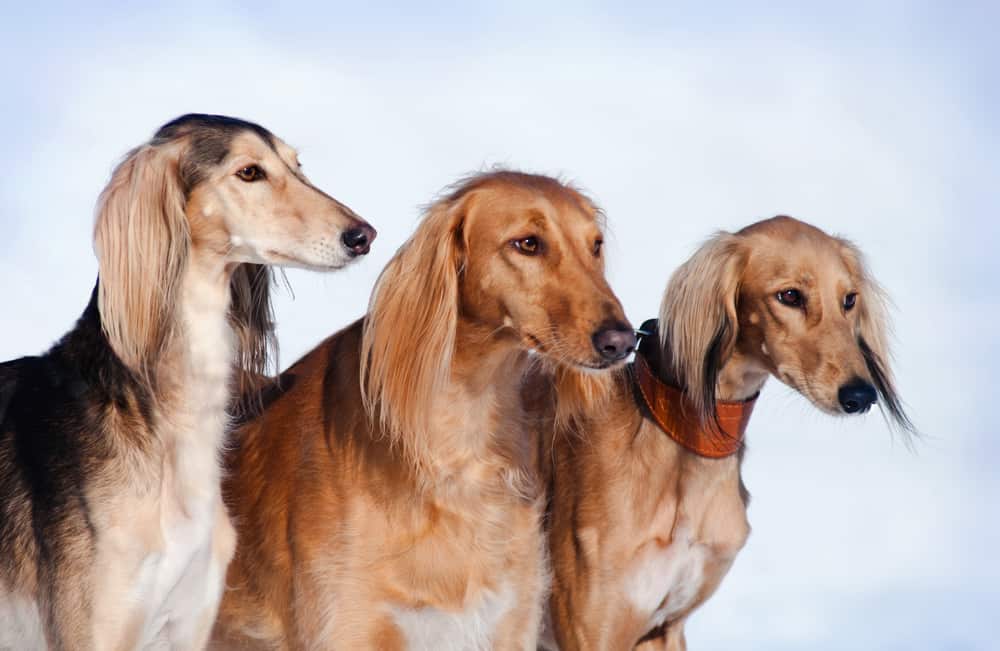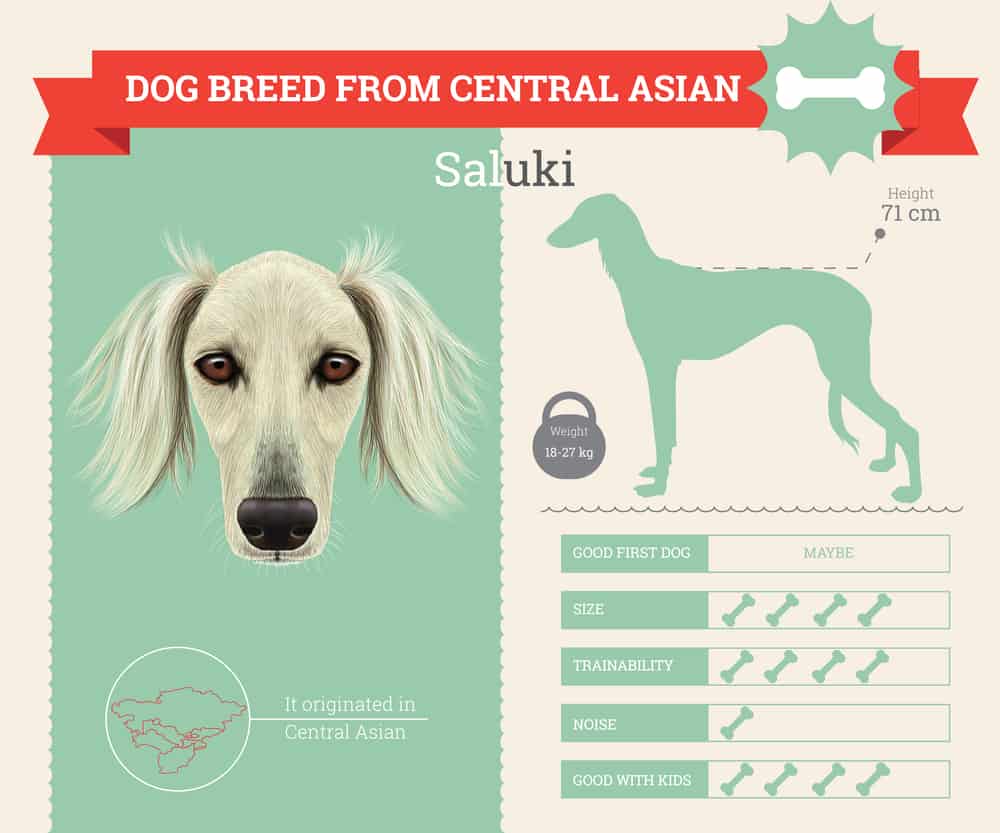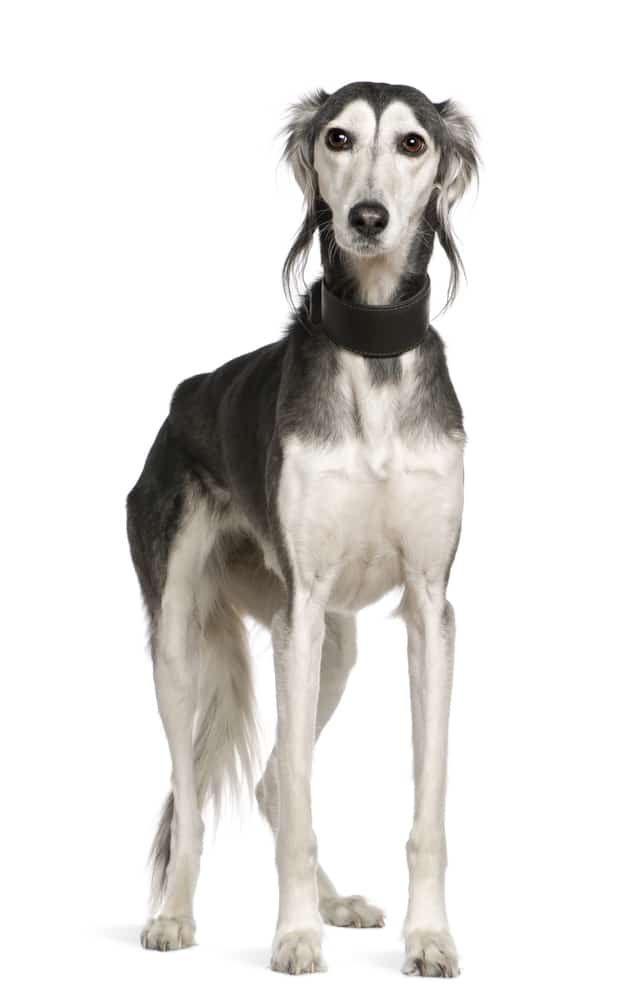Complete Guide To The Saluki: Health, Grooming, Exercise and More
The sensitive Saluki is among the Earth’s oldest breeds. A favorite of the Pharaohs’, they’re dignified dogs with gentle spirits and a passion for life.
In my veterinary practice, Salukis are not that common but each is so distinctive in their own way. Saluki owners, I’ve come to realize, are passionate about their dogs. Read further to find out if bringing a Saluki into your family is right for you!

Table of Contents
How Big Does A Saluki Get?
| Height | Weight | |
| Male | 25″ – 28″ at the shoulder | 50-60 lbs |
| Female | 23″ – 25″ at the shoulder | 35-50 lbs |
Salukis are definitely a breed where the male dog is distinctly larger than the female.
What Does A Saluki Look Like?
Long and lean, they have slender legs, a deep chest and muscular hindquarters ending with a thin, well-feathered tail — they’re the picture of grace, confidence and symmetry. Long silky ears frame a delicate, tapered muzzle and bright eyes ranging in color from hazel to brown.
Their short coats come in two varieties, feathered and smooth. Colors include:
| Black | Black and Silver | Black and Tan | Chocolate |
| Chocolate and Tan | Red | Silver | Golden |
| Cream | Fawn | White |
White markings and a grizzled pattern are common. Unchanged for nearly 9,000 years, they resemble the equally ancient Afghan Hound.

What Is The Personality Of A Saluki?
Salukis are devoted but not overly demonstrative — they’re partners, not lapdogs. Intelligent and energetic, they’re quiet at home and will be content in apartments as long as they get enough activity. They need a family committed to daily exercise.
Though generally good-natured with children, Salukis are polite, soft-spoken dogs that may bristle in noisy places. Early socialization helps them be more adaptable to changing environments. Independent and occasionally strong-willed, obedience training is recommended.
How Much Exercise Does A Saluki Need?
Salukis will nap for hours between bursts of activity, but when they’re ready to run, don’t keep them waiting. Long walks are good everyday exercise — plan on 30 minutes or more — but they have a need for speed and won’t be satisfied without the occasional sprint. Clocked at over 30 miles per hour, they’re not as fragile as they seem.
Options include exercising them in secure, open spaces where they can reach top speeds. Phenomenal jumpers, fences should be at least 6-feet high. Lure coursing, a canine sport that lets them chase a motor-driven lure on a line is a favorite activity.

In fact, if you are looking for a challenge for your Saluki, consider a triathlon! No, you won’t need to teach your dog how to ride a bicycle. The Saluki Club of America has created a Triathlon to rank the best overall Saluki.
The three events that comprise the Saluki Triathlon include:
- Triathlon Conformation
- Lure Coursing
- One of the following companion events: Agility, Rally, or Obedience
The Triathlon is held at the Saluki National every year. Full rules and qualifications can be found here.
How Much Grooming Does A Saluki Need?
Salukis require minimal grooming regardless of coat type. Smooth-coated dogs need an occasional brushing and a rare bath. Fastidious, they rarely have a doggy odor and need shampoos only when visibly soiled.
Feathered coats need more care. Hair on the ears, legs and tail can tangle — weekly combing prevents mats. But the most significant grooming issue Saluki owners face is keeping the long feathers on their ears out of their food bowls.
Clipping their hair is one solution, but it’s a drastic measure. A snood — a hood that contains their ears while they eat — is a popular and gentle alternative. They’re comfortable and well-tolerated.
Regular ear care is essential for Salukis. Once a month, use a dab of pH-balanced cleansing solution on a cotton ball or gauze pad to wipe out excess wax and discourage the growth of bacteria.
Nail care is less of a worry because Salukis are typically active enough to keep them naturally short. But overgrowth can be a hazard, so it’s important to trim or file them if they’re long enough to hear them clicking on the floor.
What Kind of Dog Food Is Good For A Saluki?
Salukis don’t have any specific nutritional requirements. Make sure you feed them based on their lean body mass. I have definitely seen overweight Salukis who are simply getting too many calories.
Best Adult Food For Salukis:
- Purina Pro Plan Large Breed
- Eukanuba Adult Dry Dog Food
- Nutro Natural Choice Large Breed Adult
- Merrick Classic Healthy Grains Dry Dog Food
Please don’t listen to the folks at the pet store trying to convince you to buy a grain-free diet for your dog. There’s zero science behind that and vets are actually seeing diseases now related to feeding grain-free foods.
How Long Does A Saluki Live?
10-17 years based on information from the AKC

What Health Problems Can Salukis Have?
So why such a wide variation in the length of life of a Saluki? I’m honestly not sure why. Most breeds have a tighter window of 2-4 years and is affected by things like how healthy the breed generally is as well as the overall size of the dog.
My personal experience is that Salukis, when totally healthy, live to about 14-15 years of age. If you look at the statistics kept by the Canine Health Information Center, Salukis are a quite healthy breed.
When Salukis do have some issues, the most common ones I’ve seen include:
- Heart Disease – this can involve valvular disease or a cardiomyopathy that ultimately causes arrhythmias. Any Saluki found to have a heart murmur or enlarged heart should have an evaluation by a veterinary cardiologist.
- Dental Disease – quite common among sight hound breeds. I highly recommend checking out my article on how to keep your dog’s teeth healthy to keep your Saluki from needing a dental cleaning.
- Hypothyroidism – if you start noticing your Saluki slowing down a bit and gaining weight, have your veterinarian run a thyroid screen to check for this easily treated issue.
- Bloat – any deep-chested dog is at risk for this condition. Too much air swallowed into the stomach can cause the organ to expand rapidly. This can be a life-threatening condition if not corrected as the bloated stomach can twist on itself to become a GDV. Best management practice is to not feed your dog within a hour of any moderate to heavy exercise (this is both before and after eating).
Are Salukis more sensitive to anesthesia than other breeds? The very lean ones are. This has to do with how dogs metabolize anesthetic drugs. It can be tricky to keep a dog this lean and large under a proper amount of anesthesia without going too deep.
You’ll want to make sure that your veterinarian is comfortable and experienced with dogs such as these before doing any procedure requiring anesthesia. Thankfully most of the drugs used today in veterinary anesthesia are short-acting and are far, far safer than drugs used even 10 years ago.
Where Can I Find Out More About The Saluki?
Where Can I Find A Saluki?
Breeder Listings from the Saluki Club of America
Looking for a Rescue? The Saluki Club of America is the starting point for that. By contacting their rescue liaison, they can put you in touch with potential rescue groups in your area.
Interesting Facts About the Saluki
The Saluki is one of several sighthounds with an ancient history. Here are a few intriguing facts about this stylish breed.
• They’re the Royal Dog of Egypt
Not even the Pharaoh Hound was as revered by Egyptian nobility as the Saluki. Their likeness is found in ancient Egyptian artifacts. They were held in such high esteem that they were mummified and entombed — a process usually reserved for high officials.
• And a Gift from God Among the Arabs
The Bedouin called the Saluki “el hor,” meaning noble. Considered rare and valuable possessions, they were used to hunt gazelle. Among ancient Arab tribes, it’s the only type of animal allowed into the home of its master.
• Salukis are a Basal Breed
Salukis are one of 16 basal breeds that include Afghan Hounds, Chow Chows and Siberian Huskies. Among the oldest dogs in history, they have a significant genetic influence on modern breeds and look much the same today as they did thousands of years ago.
• They Give Greyhounds a Run for Their Money
Greyhounds are considered the world’s fastest dogs in sprints up to 800 meters, but Salukis are faster over long distances. A 1996 record-holder was clocked at over 48 miles per hour.
